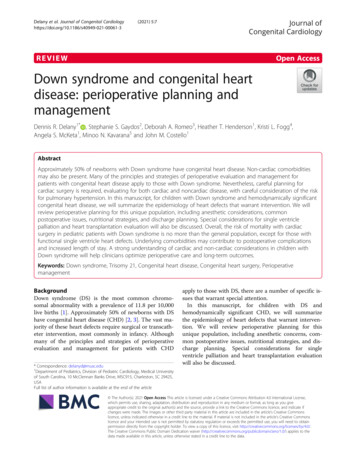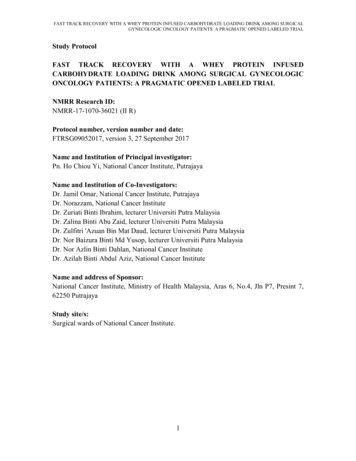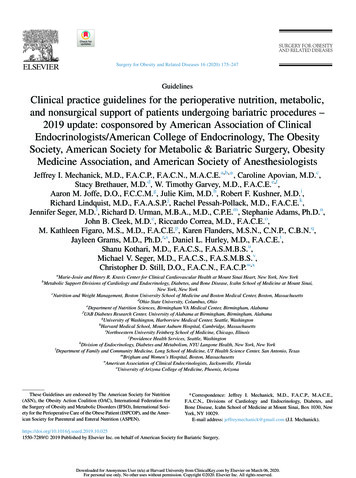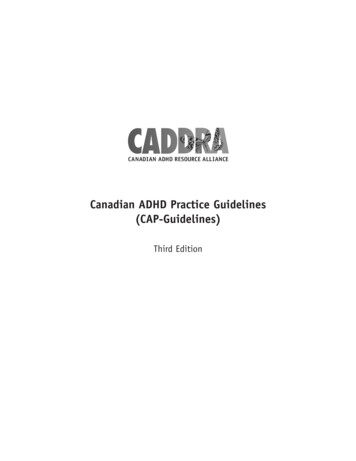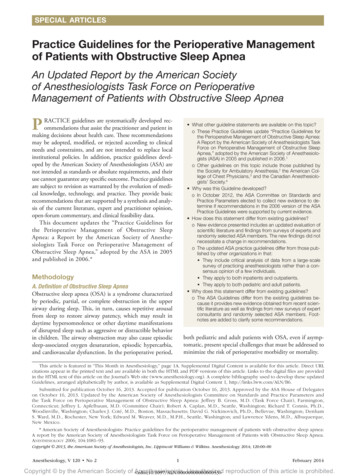
Transcription
SPECIAL ARTICLESPractice Guidelines for the Perioperative Managementof Patients with Obstructive Sleep ApneaAn Updated Report by the American Societyof Anesthesiologists Task Force on PerioperativeManagement of Patients with Obstructive Sleep ApneaPRACTICE guidelines are systematically developed recommendations that assist the practitioner and patient inmaking decisions about health care. These recommendationsmay be adopted, modified, or rejected according to clinicalneeds and constraints, and are not intended to replace localinstitutional policies. In addition, practice guidelines developed by the American Society of Anesthesiologists (ASA) arenot intended as standards or absolute requirements, and theiruse cannot guarantee any specific outcome. Practice guidelinesare subject to revision as warranted by the evolution of medical knowledge, technology, and practice. They provide basicrecommendations that are supported by a synthesis and analysis of the current literature, expert and practitioner opinion,open-forum commentary, and clinical feasibility data.This document updates the “Practice Guidelines forthe Perioperative Management of Obstructive SleepApnea: a Report by the American Society of Anesthesiologists Task Force on Perioperative Management ofObstructive Sleep Apnea,” adopted by the ASA in 2005and published in 2006.* What other guideline statements are available on this topic?o These Practice Guidelines update “Practice Guidelines forthe Perioperative Management of Obstructive Sleep Apnea:A Report by the American Society of Anesthesiologists TaskForce on Perioperative Management of Obstructive SleepApnea,” adopted by the American Society of Anesthesiologists (ASA) in 2005 and published in 2006.1o Other guidelines on this topic include those published bythe Society for Ambulatory Anesthesia,2 the American College of Chest Physicians,3 and the Canadian Anesthesiologists’ Society.4 Why was this Guideline developed?o In October 2012, the ASA Committee on Standards andPractice Parameters elected to collect new evidence to determine if recommendations in the 2006 version of the ASAPractice Guidelines were supported by current evidence. How does this statement differ from existing guidelines?o New evidence presented includes an updated evaluation ofscientific literature and findings from surveys of experts andrandomly selected ASA members. The new findings did notnecessitate a change in recommendations.o The updated ASA practice guidelines differ from those published by other organizations in that: They include critical analysis of data from a large-scalesurvey of practicing anesthesiologists rather than a consensus opinion of a few individuals. They apply to both inpatients and outpatients. They apply to both pediatric and adult patients. Why does this statement differ from existing guidelines?o The ASA Guidelines differ from the existing guidelines because it provides new evidence obtained from recent scientific literature as well as findings from new surveys of expertconsultants and randomly selected ASA members. Footnotes are added to clarify some recommendations.MethodologyA. Definition of Obstructive Sleep ApneaObstructive sleep apnea (OSA) is a syndrome characterizedby periodic, partial, or complete obstruction in the upperairway during sleep. This, in turn, causes repetitive arousalfrom sleep to restore airway patency, which may result indaytime hypersomnolence or other daytime manifestationsof disrupted sleep such as aggressive or distractible behaviorin children. The airway obstruction may also cause episodicsleep-associated oxygen desaturation, episodic hypercarbia,and cardiovascular dysfunction. In the perioperative period,both pediatric and adult patients with OSA, even if asymptomatic, present special challenges that must be addressed tominimize the risk of perioperative morbidity or mortality.This article is featured in “This Month in Anesthesiology,” page 1A. Supplemental Digital Content is available for this article. Direct URLcitations appear in the printed text and are available in both the HTML and PDF versions of this article. Links to the digital files are providedin the HTML text of this article on the Journal’s Web site (www.anesthesiology.org). A complete bibliography used to develop these updatedGuidelines, arranged alphabetically by author, is available as Supplemental Digital Content 1, http://links.lww.com/ALN/B6.Submitted for publication October 16, 2013. Accepted for publication October 16, 2013. Approved by the ASA House of Delegateson October 16, 2013. Updated by the American Society of Anesthesiologists Committee on Standards and Practice Parameters andthe Task Force on Perioperative Management of Obstructive Sleep Apnea: Jeffrey B. Gross, M.D. (Task Force Chair), Farmington,Connecticut; Jeffrey L. Apfelbaum, M.D. (Committee Chair); Robert A. Caplan, M.D., Seattle, Washington; Richard T. Connis, Ph.D.,Woodinville, Washington; Charles J. Coté, M.D., Boston, Massachusetts; David G. Nickinovich, Ph.D., Bellevue, Washington; DenhamS. Ward, M.D., Rochester, New York; Edward M. Weaver, M.D., M.P.H., Seattle, Washington; and Lawrence Ydens, M.D., Albuquerque,New Mexico.* American Society of Anesthesiologists: Practice guidelines for the perioperative management of patients with obstructive sleep apnea:A report by the American Society of Anesthesiologists Task Force on Perioperative Management of Patients with Obstructive Sleep Apnea.Anesthesiology 2006; 104:1081–93.Copyright 2013, the American Society of Anesthesiologists, Inc. Lippincott Williams & Wilkins. Anesthesiology 2014; 120:00–00Anesthesiology, V 120 No 21February 2014Copyright by the American Society of Anesthesiologists.Unauthorized reproduction of this article is prohibited. zdoi;10.1097/ALN.0000000000000053
Practice Guidelinesmanagement strategies for patients with OSA and (2) reviewand comment on a draft of the Guidelines developed by theTask Force. Fourth, the Task Force held open forums at twomajor national meetings to solicit input on its draft recommendations. National organizations representing most of thespecialties whose members typically care for patients withOSA were invited to participate in the open forums. Fifth,the consultants were surveyed to assess their opinions on thefeasibility and financial implications of implementing theGuidelines. Sixth, all available information was used to buildconsensus within the Task Force to finalize the Guidelines.In 2012, the ASA Committee on Standards and PracticeParameters requested that the updated Guidelines publishedin 2006 be re-evaluated. This update consists of an evaluation of literature published since completion of the original Guidelines and an evaluation of new survey findings ofexpert consultants and ASA members. A summary of recommendations is found in appendix 1.Because procedures differ among laboratories, it is notpossible to use specific values of indices such as the apnea–hypopnea index to define the severity of sleep apnea. Therefore, for the purposes of these Guidelines, patients will bestratified using the terms mild, moderate, and severe as definedby the laboratory where the sleep study was performed.B. Purposes of the GuidelinesThe purposes of these Guidelines are to improve the perioperative care and reduce the risk of adverse outcomes inpatients with confirmed or suspected OSA who receive sedation, analgesia, or anesthesia for diagnostic or therapeuticprocedures under the care of an anesthesiologist.C. FocusThese Guidelines focus on the perioperative management ofpatients with confirmed or suspected OSA who may be atincreased risk of perioperative morbidity and mortality becauseof potential difficulty in maintaining a patent airway. Thispopulation includes but is not limited to patients who havesleep apnea resulting from obesity, pregnancy, and other skeletal, cartilaginous, or soft tissue abnormalities causing upperairway obstruction. These Guidelines do not focus on patientswith the following conditions: (1) pure central sleep apnea, (2)abnormalities of the upper or lower airway not associated withsleep apnea (e.g., deviated nasal septum), (3) daytime hypersomnolence from other causes, (4) patients younger than 1 yr,and (5) obesity in the absence of sleep apnea.F. Availability and Strength of EvidencePreparation of these updated Guidelines followed a rigorous methodological process. Evidence was obtained fromtwo principal sources: scientific evidence and opinion-basedevidence (appendix 2).Scientific EvidenceScientific evidence used in the development of these Guidelines is based on findings from literature published in peerreviewed journals. Literature citations are obtained fromPubMed and other healthcare databases, direct internetsearches, task force members, liaisons with other organizations, and from hand searches of references located inreviewed articles.Findings from the aggregated literature are reported in thetext of the Guidelines by evidence category, level, and direction. Evidence categories refer specifically to the strengthand quality of the research design of the studies. Category Aevidence represents results obtained from randomized controlled trials (RCTs), and Category B evidence representsobservational results obtained from nonrandomized studydesigns or RCTs without pertinent controls. When available,Category A evidence is given precedence over Category Bevidence in the reporting of results. These evidence categoriesare further divided into evidence levels. Evidence levels referspecifically to the strength and quality of the summarizedstudy findings (i.e., statistical findings, type of data, and thenumber of studies reporting/replicating the findings) withinthe two evidence categories. For this document, only thehighest level of evidence is included in the summary reportfor each intervention, including a directional designation ofbenefit, harm, or equivocality for each outcome.D. ApplicationThese Guidelines apply to both inpatient and outpatientsettings and to procedures performed in an operating roomas well as in other locations where sedation or anesthesia isadministered. They are directly applicable to care administered by anesthesiologists and individuals who deliver careunder the medical direction or supervision of an anesthesiologist. They are also intended to serve as a resource for otherphysicians and patient care personnel who are involved in thecare of these patients. In addition, these Guidelines may serveas a resource to provide an environment for safe patient care.E. Task Force Members and ConsultantsThe original Guidelines were developed by an ASA-appointedTask Force of 12 members, consisting of anesthesiologists inboth private and academic practices from various geographicareas of the United States, a bariatric surgeon, an otolaryngologist, and two methodologists from the ASA Committeeon Standards and Practice Parameters.The original Task Force developed the Guidelines bymeans of a six-step process. First, they reached consensus onthe criteria for evidence of effective perioperative managementof patients with OSA. Second, original published researchstudies from peer-reviewed journals relevant to the perioperative management of patients with OSA were evaluated. Third,the panel of expert consultants was asked to (1) participate inopinion surveys on the effectiveness of various perioperativeAnesthesiology 2014; 120:00-00Category ARandomized controlled trials report comparative findings between clinical interventions for specified outcomes.2Practice GuidelinesCopyright by the American Society of Anesthesiologists. Unauthorized reproduction of this article is prohibited.
SPECIAL ARTICLESStatistically significant (P 0.01) outcomes are designated aseither beneficial (B) or harmful (H) for the patient; statistically nonsignificant findings are designated as equivocal (E).of these updated Guidelines. However, only the findingsobtained from formal surveys are reported.Opinion surveys were developed for this update by theTask Force to address each clinical intervention identified inthe document. Identical surveys were distributed to expertconsultants and a random sample of ASA members.Level 1: The literature contains a sufficient number of RCTsto conduct meta-analysis,† and meta-analytic findingsfrom these aggregated studies are reported as evidence.Level 2: The literature contains multiple RCTs, but thenumber of RCTs is not sufficient to conduct a viablemeta-analysis for the purpose of these Guidelines. Findings from these RCTs are reported as evidence.Level 3: The literature contains a single RCT, and findingsfrom this study are reported as evidence.Category A: Expert OpinionSurvey responses from Task Force–appointed expert consultantsare reported in summary form in the text, with a complete listing of consultant survey responses reported in appendix 2.Category B: Membership OpinionSurvey responses from active ASA members are reported insummary form in the text, with a complete listing of ASAmember survey responses reported in appendix 2.Category BObservational studies or RCTs without pertinent comparisongroups may permit inference of beneficial or harmful relationships among clinical interventions and outcomes. Inferredfindings are given a directional designation of beneficial (B),harmful (H), or equivocal (E). For studies that report statisticalfindings, the threshold for significance is P value less than 0.01.Survey responses from expert and membership sourcesare recorded by using a 5-point scale and summarized basedon median values.‡Strongly Agree: Median score of 5 (at least 50% of theresponses are 5)Agree: Median score of 4 (at least 50% of the responses are4 or 4 and 5)Equivocal: Median score of 3 (at least 50% of the responsesare 3, or no other response category or combination ofsimilar categories contains at least 50% of the responses)Disagree: Median score of 2 (at least 50% of responses are 2or 1 and 2)Strongly Disagree: Median score of 1 (at least 50% ofresponses are 1)Level 1: The literature contains observational comparisons(e.g., cohort and case-control research designs) betweenclinical interventions for a specified outcome.Level 2: The literature contains observational studies withassociative statistics (e.g., relative risk, correlation, andsensitivity/specificity).Level 3: The literature contains noncomparative observational studies with descriptive statistics (e.g., frequenciesand percentages).Level 4: The literature contains case reports.Insufficient EvidenceCategory C: Informal OpinionOpen-forum testimony obtained during development of theoriginal Guidelines, Internet-based comments, letters, andeditorials are all informally evaluated and discussed duringthe formulation of Guideline recommendations. When warranted, the Task Force may add educational information orcautionary notes based on this information.The lack of sufficient scientific evidence in the literature mayoccur when the evidence is either unavailable (i.e., no pertinent studies found) or inadequate. Inadequate literaturecannot be used to assess relationships among clinical interventions and outcomes, because such literature does not permit a clear interpretation of findings due to methodologicalconcerns (e.g., confounding in study design or implementation) or does not meet the criteria for content as defined inthe “Focus” of the Guidelines.GuidelinesI. Preoperative EvaluationPreoperative evaluation of a patient for potential identification of OSA includes (1) medical record review, (2) patient/family interview and screening protocol, and (3) physicalexamination.Medical Record Review. The literature is insufficient to evaluate the efficacy of conducting a directed medical history orreviewing previous medical records to identify the presenceof OSA. Observational studies comparing OSA with nonOSA patients report higher body mass index values for OSApatients5–15; similarly, when obese patients are compared withnonobese patients, higher frequencies of OSA are reported16–18(Category B1-H evidence). Comparative observational studiesOpinion-based EvidenceAll opinion-based evidence (e.g., survey data, open-forumtestimony, internet-based comments, letters, and editorials)relevant to each topic was considered in the development† All meta-analyses are conducted by the ASA methodology group.Meta-analyses from other sources are reviewed but not included asevidence in this document.‡ When an equal number of categorically distinct responses areobtained, the median value is determined by calculating the arithmetic mean of the two middle values. Ties are calculated by a predetermined formula.Anesthesiology 2014; 120:00-003Practice GuidelinesCopyright by the American Society of Anesthesiologists. Unauthorized reproduction of this article is prohibited.
Practice Guidelinesreport other pertinent patient characteristics associated withOSA that may be available in medical records, such as hypertension,19–23 history of stroke,24,25 history of myocardialinfarction,26 diabetes mellitus,23 or abnormal cephalometricmeasurements.27–53 (Category B1-H evidence). Noncomparative observational studies and case reports indicate that certaincongenital conditions (e.g., Down syndrome, acromegaly)54–56and disease states (e.g., neuromuscular disease, cerebral palsy)57may also be associated with OSA (Category B3-H evidence).Patient/Family Interview and Screening Protocol. The literature is insufficient to evaluate the efficacy of conducting apatient or family interview to identify the presence of OSA.Observational studies evaluating screening protocols or questionnaires to identify adult OSA patients report sensitivityvalues ranging from 36 to 86%, specificity values rangingfrom 31 to 95%, positive predictive values ranging from 72to 96%, and negative predictive values ranging from 30 to82%, based on apnea–hypopnea index or respiratory disturbance index scores of 5 or more (Category B2-B evidence).58–65Physical Examination. The literature is insufficient to evaluate the efficacy of conducting a directed physical or airwayexamination to identify the presence of OSA. Comparativeobservational studies report differences in neck circumference,66–68 tongue size,69 and nasal and oropharyngeal airway structures69–71 when comparing OSA with non-OSApatients (Category B1-H evidence). Observational studies alsoreport associations between tonsil size and apnea–hypopneaindex or respiratory disturbance index scores in adult OSApatients (Category B2-H evidence).72–74The consultants and ASA members strongly agree thatanesthesiologists should work with surgeons to develop aprotocol whereby patients in whom the possibility of OSAis suspected on clinical grounds are evaluated long enoughbefore the day of surgery to allow preparation of a perioperative management plan. They also both strongly agree thatpreoperative evaluation should include (1) a comprehensivereview of previous medical records (if available), (2) an interview with the patient and/or family, and (3) conducting aphysical examination. The consultants and ASA membersboth agree that if any characteristics noted during the preoperative evaluation suggest that the patient has OSA, the anesthesiologist and surgeon should jointly decide whether to (1)manage the patient perioperatively based on clinical criteriaalone, or (2) obtain sleep studies, conduct a more extensiveairway examination, and initiate indicated OSA treatmentin advance of surgery. The consultants agree and the ASAmembers strongly agree that if the preoperative evaluationdoes not occur until the day of surgery, the surgeon andanesthesiologist together may elect for presumptive management based on clinical criteria or a last-minute delay of surgery. Both the consultants and ASA members strongly agreethat the severity of the patient’s OSA, the invasiveness of thediagnostic or therapeutic procedure, and the requirementfor postoperative ana
areas of the United States, a bariatric surgeon, an otolaryn-gologist, and two methodologists from the ASA Committee on Standards and Practice Parameters. The original Task Force developed the Guidelines by means of a six-step process. First, they reached consensus on the criteria for evidence of effective perioperative management






